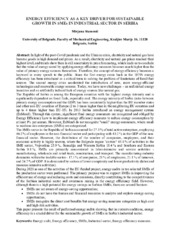Приказ основних података о документу
ENERGY EFFICIENCY AS A KEY DRIVER FOR SUSTAINABLE GROWTH IN SMEs IN INDUSTRIAL SECTOR IN SERBIA
| dc.creator | Stamenić, Mirjana | |
| dc.date.accessioned | 2023-03-15T08:15:07Z | |
| dc.date.available | 2023-03-15T08:15:07Z | |
| dc.date.issued | 2022 | |
| dc.identifier.isbn | 978-86-7877-030-2 | |
| dc.identifier.uri | https://machinery.mas.bg.ac.rs/handle/123456789/6286 | |
| dc.description.abstract | In light of the post-Covid pandemic and the Ukraine crisis, electricity and natural gas have become goods in high demand and prices. As a result, electricity and natural gas prices reached their highest level, and trends show there is still uncertainty in price forecasting, which leads us to conclude that the value of energy saved by applying energy efficiency measures becomes much higher than the value of primary energy sources themselves. Therefore, the concept of energy efficiency becomes a keyword in every speech to the public. Since the first energy crisis back in the 1970’s energy efficiency has been introduced as a critical term in solving the problem of limitations of fossil fuel sources. The second energy crisis accelerated the introduction of new, more energy-efficient technologies and renewable energy sources. Today, we have new challenges – an unfinished energy transition and an artificially induced lack of energy sources like natural gas. The Republic of Serbia is among the European countries with the highest energy intensity and is significantly dependent on fossil fuels, especially coal. The energy intensity of Serbia (ratio between primary energy consumption and the GDP) has been consistently higher than the EU member states and other non-EU countries of Europe (2 to 3 times higher than in the neighboring EU countries and up to 4 times higher than EU-15). In 2013 Serbia introduced an energy management system (EnMenS). Through this system, significant final energy consumers are recognized and obliged by Energy Efficiency Law to implement energy efficiency measures to reduce energy consumption by at least 1% per annum. However, EnMenS do not recognize “small” energy consumers, where small to medium size enterprises (SMEs) are categorized. The SMEs sector in the Republic of Serbia accounted for 27.3 % of total active enterprises, employing 46.2 % of employees in the non-financial sector and participating with 43.2 % in the GDP of the non-financial sector. However, the distribution of the number of companies, employees, and their economic activity is highly uneven, where the Belgrade region “carries” 45.8 % of activities in the SME sector, Vojvodina 25.9 %, Šumadija and Western Serbia 18.4 % and Southern and Eastern Serbia 9.8 %. SMEs are primarily concentrated in labor-intensive and service activities - manufacturing, wholesale and retail trade, construction, and transport. The manufacturing industry dominates within the tradable sector - 17.1 % of companies, 28 % of employees, 21.1 % of turnover, and 24.7 % of GDP. It is dominated by sectors of lower complexity and lower productivity (labor and resource-intensive activities). During 2021 energy audits in ten selected SMEs of the production sector were performed. The primary purpose was to support SMEs in improving the efficient use of energy and reducing costs and emissions, directly contributing to the competitiveness of the Serbian industrial sector and awareness raising in the energy efficiency field. However, although there is a high potential for energy savings in Serbian SMEs, there are several barriers: - SMEs are not aware of energy-saving opportunities; - SMEs do not have the human and financial resources to analyze and explore energy-saving opportunities; - SMEs recognize the direct cost benefits, but energy-saving measures categorize as high-cost and high-risk activities. This paper presents the result of performed energy audits showing that in current conditions, energy efficiency is a crucial driver for the sustainable growth of SMEs in Serbia’s industrial sector. | sr |
| dc.language.iso | en | sr |
| dc.publisher | Society of Thermal Engineers of Serbia | sr |
| dc.rights | openAccess | sr |
| dc.rights.uri | https://creativecommons.org/licenses/by-nc-nd/4.0/ | |
| dc.source | Proceedings of International Conference "IEEP 2022", November 08-09, 2022, Faculty of Mechanical Engineering of the University of Belgrade | sr |
| dc.subject | Energy audit | sr |
| dc.subject | Energy efficiency | sr |
| dc.subject | SMEs | sr |
| dc.subject | Industrial sector | sr |
| dc.subject | Energy efficiency measures | sr |
| dc.title | ENERGY EFFICIENCY AS A KEY DRIVER FOR SUSTAINABLE GROWTH IN SMEs IN INDUSTRIAL SECTOR IN SERBIA | sr |
| dc.type | conferenceObject | sr |
| dc.rights.license | BY-NC-ND | sr |
| dc.citation.spage | 84-96 | |
| dc.identifier.fulltext | http://machinery.mas.bg.ac.rs/bitstream/id/15555/bitstream_15555.pdf | |
| dc.identifier.rcub | https://hdl.handle.net/21.15107/rcub_machinery_6286 | |
| dc.type.version | publishedVersion | sr |


